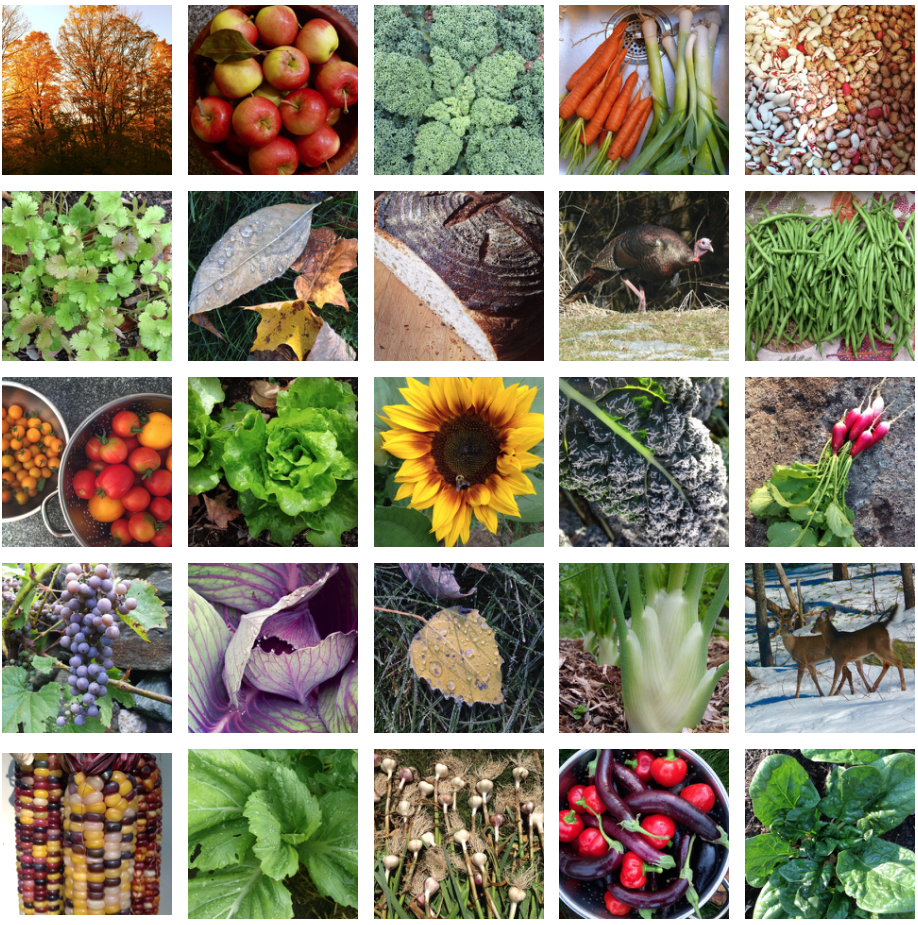
The river drains a northern watershed of roughly seven thousand square miles. Streams and rivulets cut veins across the bedrock, and even our own three acres play a tiny part, a narrow trickle in our woods seeping from the granite hillside, slouching westward to join the river as it slips south into Long Island Sound.
The river unites our states, but the land is different west to east, the result of slow tectonic chaos. Our collective rock formed four hundred million years ago, when ur-Vermont was under teeming tropical waters, and ur-New Hampshire was under black polar sea. The plates pressed together along a north-south seam, creating mountains to rival the Himalayas, which time wore down to stubs. Much later it was all under a mile of ice, which scraped and dragged the landscape clean. Vermont got a jolt of silt when the melt water receded, so that land now skews fertile and sweet, while ours skews bony and sour.
The Western Abenaki, who settled the land two thousand years before the Europeans arrived, learned to live mostly off wild-harvested plants and game, practicing subsistence agriculture to smooth the seasonal gaps. The European settlers who spread across New England soon learned the riddle of the soils. To the east they focused on forestry, scratching a meager living from the landscape while shipping off timber to build the Northeast’s cities. To the west, though, their plows broke fertile valleys into fields for agriculture and animal husbandry. Vermont’s production still outpaces that of its neighbor, which is why “Vermont” is now as much brand as terroir.
Perhaps, four paragraphs and several geologic eons into this story, you’re wondering what any of this has to do with Thanksgiving. But New England more or less invented the Thanksgiving meal, or at least safeguards its creation myth, and that invention is rooted in something, namely the land, and what the land can yield.
It yields plenty.
At harvest in New England we’re flush with pumpkins, root crops, apples, corn, cranberries, bitter greens, game birds, venison, nuts. All of our regional forebears would have known these foods, whether they’d arrived on foot across the Bering ice sheet or packed into the hull of an Atlantic ship. These harvest flavors now form the basis of the traditional Thanksgiving meal, and have found their way onto American tables everywhere. In parts of the country where they give thanks with a Southern accent, you’ll also find collards and sweet potatoes. In the West the meal’s inflected with chile, tomatillo, and smoke. But the meal’s Northeastern origins are always deliciously apparent.
Thanksgiving is a harvest meal. We gather now because the food is ample, and because we’re tired. Having snugged our produce into long-term storage, canned our beans and dried our garlic, stowed our jams and pickles, cured our sausage, shot and frozen our deer, we deserve a rest. We now, at least traditionally, theoretically, have the time to sit down and savor it all, to reflect on our good fortune, on the privilege of abundance.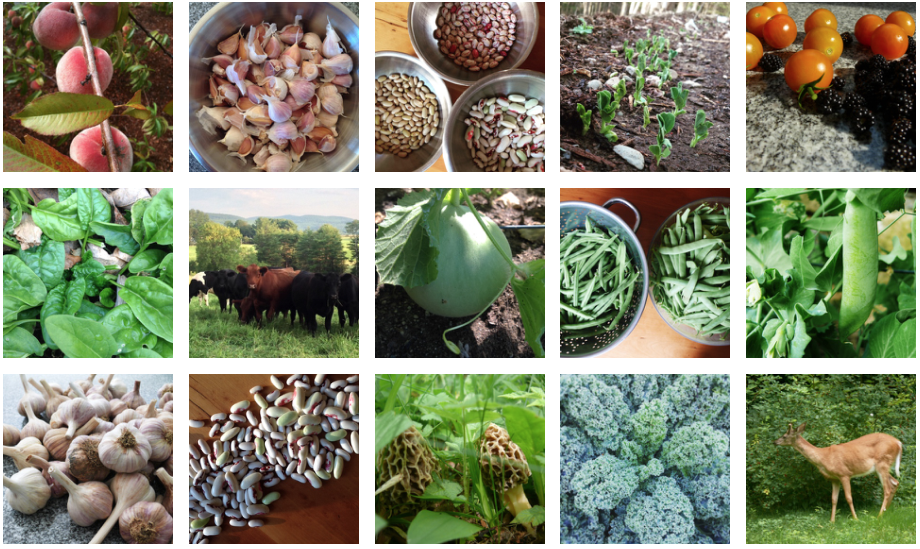
I tend a garden here, too, perched on that liminal seam that divides our landscape. I used to grow nearly all of my household’s vegetables, both fresh foods and storage crops, like dent corn for flour, dried beans, alliums, and hardy squashes. But that was long ago, and our present site is challenging, sloped and partly shaded. Still, I can coax a slender rotation of vegetables from New Hampshire’s gravely soils. The planting begins with peas in April and ends with garlic in November, when I also pull the last of my carrots and leeks before the ground locks up, nursing the spinach, lettuces, and herbs through the first hard frosts. The kale often makes into December, when its leaves begin to whither into ragged leathery sheets, which, by February, the deer resignedly nibble to stubble.
During the heat of growing season, though, from July through August, I can often base our meals on what the garden gives us. Maybe one night it’s eggplant-centric, another night it’s all about beans and greens. There are always a few imports, foods that come from a few or few hundred miles away—cheese or eggs, bread, a filigree of oils and nuts, ginger, other seasonings. These meals are precious to me, the most satisfying of the year, when the vast majority of what’s on the table derives, by volume if not by total calories, from our own backyard.
So the food is here. Right now the food is everywhere.
My husband and I sometimes travel away to be with family at Thanksgiving, and sometimes host a small crowd here. Last Thanksgiving, though, it was to be just the two of us alone. That would make the meal feel less Thanksgiving feast, more Thursday night supper. I wasn’t cooking for a crowd or trying to impress anyone. The stakes, in other words, were low. And so, partly out of romantic idealism, and partly out of undecorated pragmatism, I decided to cook an all-local meal.
Or try to.
I set some ground rules. First: all locally grown. The fruits, vegetables, meats, dairy, cheeses, grains, seeds, fats, and herbs would derive from Vermont, New Hampshire, or my own backyard.
Second, locally sourced wasn’t enough. Hence no Lake Champlain Chocolates, no Vermont Coffee Company. All ingredients must be grown here, not just made here into something else.
Third, no extra fuss. No long hunts for replacement ingredients. Use what’s ample and abundant, cooking the way our forebears did (or, let’s be honest, had to).
But: Don’t go crazy. I would cook the traditional New England Thanksgiving meal, but I would give myself a bye for salt pepper, and spices for the pie.
What would I be giving up? Refined white flour. Vanilla for the whipped cream. Palm oil, which is solid at room temperature and which I use in lieu of shortening for pie crust. Olive oil (ouch). Celery, which adds essential aromatics to dressing, stock, and gravy. One farm grows it locally, but that would have required a special trip, violating the no-fuss rule.
Wine. Yikes. Yes, wine is made in all fifty states, and I’ve written glowingly about several Vermont producers (read a couple of those stories here and here). But rather than go to great lengths to procure these wines, I decided on an even more local option: hard cider. Farnum Hill’s large heirloom orchard spreads across a hilltop fifteen miles away, and their ciders are affordable, readily available, deeply autumnal, and a match for Thanksgiving flavors.
Lucky for us our local cooperative grocery, one of the nation’s oldest and largest, has a philosophical commitment (and perhaps a philanthropic one, given the slender margins) to supporting local producers. So even though most of the farm stands were shuttered and my own garden was shutting down, I knew I could readily buy ingredients for the meal at the store I patronize weekly.
Still, there were choices to be made. Since I was cooking only for two, a full turkey was contraindicated. Plus, local turkey prices soar in November, and we’d have spent nearly twenty dollars on a small breast. On the other hand, the coop sources whole pigs from a farm ten miles away, then works them down into cuts, and the meat is sweet and pure tasting and always available. A roasted pork loin with apples and cider and cranberries sounded seasonally appropriate. Actually, it sounded delicious.
So I stopped by the meat counter five days in advance to place an order for the loin, which I’d pick up Wednesday evening while shopping for the final fresh ingredients. Pigs arrive on Wednesdays, they told me, so there should be no problem. Still, the day before Thanksgiving is one of the busiest of the year at that meat counter, and when I called midday to confirm that my order had been wrapped and set aside, I learned that the pig had gotten a Thanksgiving pardon.
I mulled other centerpieces for the meal. I had some local lamb Merguez sausage in my freezer, but spicy seemed out of keeping with the New England theme. So I decided to wing it and make my final choice once at the store, another nod to availability rather than to some ideal of what Thanksgiving should be. Happily the coop had a few fresh local fryer chickens, so along with my cheeses and eggs, flours, bread, and greens, I packed home a four-pound bird. It would be poultry after all.
Then the meal expanded. Wednesday night brought a snowstorm, with sleet and driving piles of white. A friend had to cancel her Thanksgiving trip to be with family in the southern part of the state. And then we learned another friend had no plans, either. And so to save them from the fate of toast and tea on Thanksgiving night, or maybe popcorn and Champagne (there are admittedly worse fates), our table would seat four.
Thursday morning after breakfast I gathered my ingredients and took stock. Some of the food had been grown just a few steps from the kitchen door: kale, carrots, herbs, onions, shallots, leeks, garlic. Some was from New Hampshire: apples, cider, squash, cheese, cream, eggs. But in a nod to Vermont’s fertility, most of it hailed from across the river: bread, butter, honey, maple syrup, flour, raspberries, cranberries, potatoes, five additional cheeses, and that fryer chicken. Much of it was organically certified, but not all of it, and anyway I often opt for local non-certified over distant certified, because I value both freshness and sustainability.
The traditional New England Thanksgiving dishes are actually pretty simple: roasted poultry, mashed potatoes, baked squash, greens, pie. The seasonings aren’t elaborate, tilting toward herbs and spice and butter. This meal wouldn’t be hard, in other words, but I was looking forward to working with that small added constraint of locality.
I’m an experienced scratch cook. I figure my job is to take perfect ingredients and coax them into their highest and best state. Sometimes that’s simply raw; a carrot just pulled from the garden doesn’t need much more than a rinse. Sometimes it’s more elaborate, like lasagna with hand-made pasta, homegrown spinach, my own tomatoes in the sauce. I’ll happily labor for hours to produce a meal, but my aesthetic is more essentialist than elegant. I get impatient with fussy, high-concept cuisine. I’m more intuitive and interpretive, and while I rarely refer to recipes, it’s not about bravura, it’s more about wanting to find my own way forward.
Still, as I set about cooking, I began to notice a few things. First, cooking all-local made me parsimonious. Or rather, even more parsimonious (I’m a New Englander, after all). Every ingredient seemed more precious and special. Once I’d used something up, it was gone. Forever. Running out to the store wasn’t an option, because of the holiday and because ironically our tiny local store would not have local food. And everything I’d grown myself seemed especially exquisite and rare. I only had so many of my own shallots left. The kale—that day I’d kicked eight inches of new snow off the one remaining stalk, then snapped the last top lobes. It’s kale’s sweetest part, but this was its bitter end.
And butter! I’d bought only one pound, which seemed extravagantly enough when cooking for two. But when your guest list doubles, and you’re making a whole pie and roasting a bird, and prepping lots of sides, a pound of butter is not a lot of butter. And of course the choice not to use oil meant that all of the sauté fat would be butter, too. So I decided against mashed potatoes, for example, which sop up an astonishing amount of fat, to be sure to have enough butter for a pie crust.
The pie was itself an exemplar of cooking within constraints. Butter’s a problematic pastry fat. It’s tasty, but its high water content needs to be managed. I could have clarified it, but then wouldn’t have had enough. I might have used lard, but knew of no local source that purifies it. Adding complexity was the absence of local refined flour. In the last decade a handful of Vermont growers have begun producing wheat, and local granaries churn out a range of grades, including whole-wheat pastry. But I’ve never seen a local white flour, let alone bleached white or cake, for reasons likely more political than gastronomic. So, one-hundred-percent whole-wheat pastry it was.
For the pie filling I used apples and cranberries, tossing in a few raspberries grown in a friend’s patch. No problem there. For sweetening I used a honey and cider reduction, which made the filling wet. I could have thickened this with flour, but worried it would be gummy, and this pie was already putting on weight. So I flexed and used cornstarch. One tablespoon. Not local. At least it was non-GMO organic.
Also, I wanted gravy, and that big-for-two, now tiny-for-four chicken wasn’t going to cut it. I did, though, have some chicken stock in the freezer that I’d made after roasting another Vermont bird, using my own onions, garlic, carrots, and herbs for seasoning. But there was some celery in the mix, again non-local, and I’d roasted it with olive oil (as usual).
I used the stock. 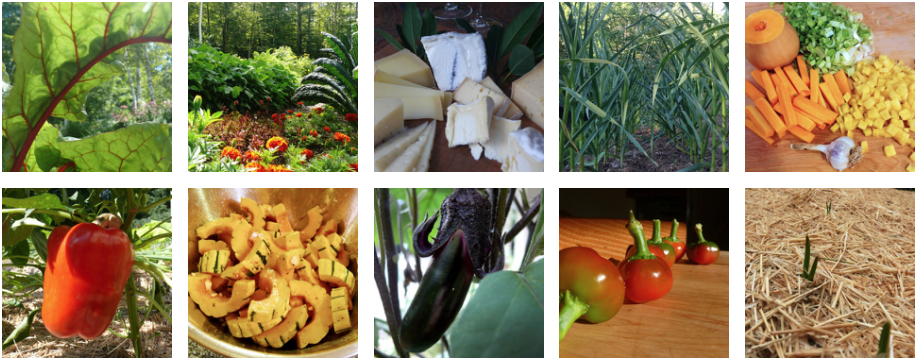
It all came together with very little trash. When you cook locally, you don’t have a lot of packaging. You have a lot of compost, but you don’t have lot of paper and plastic.
The guests arrived. We ate after dark. It felt partly like Thanksgiving, and partly just like dinner, a New England harvest dinner. Sure, I’d given up a few ingredients to make this meal, but in the end it wasn’t about giving up, it was about giving thanks, about making a feast out of what the land had delivered.
So how was it? The bad news first: The roasted squash seeds were chewy; I should have baked them instead. The piecrust was predictably heavy; next time I’d opt for fruit crumble.
But the local cheeses were, as always, exquisite. The bread and all of the vegetables were excellent. The cranberry sauce was perfect. The gravy was great. The bird—well, it’s hard to screw up roasted bird, and I didn’t.
In the end we did have wine. One of our guests has a very deep cellar, with more perfectly aged Rhônes than he can hope to drink in his lifetime. And so after our cider toast, we opened the reds he had brought along. Because the spirit of this meal is sharing, and because perhaps the most important rule of all? Don’t go crazy.
Food Sources
I wound up with foods from fifteen Vermont and six New Hampshire producers, in addition to what I’d grown myself.
First, the imports: salt, pepper, nutmeg, cinnamon, cornstarch, baking powder, vinegar, and wine
Chicken: Misty Knoll Farms, New Haven, Vermont
Eggs: Mac’s Happy Hens, Plainfield, Vermont
Cream: Strafford Organic Creamery at Rock Bottom Farm, Strafford, Vermont
Cheeses: Lake’s Edge, Blue Ledge Farm, Salisbury, Vermont; Kinsman Ridge, Landaff Creamery Cellars at Jasper Hill, Landaff, New Hampshire; Weybridge, Landaff Creamery Cellars at Jasper Hill, Landaff, New Hampshire; Boggy Meadow Farm Baby Swiss, Walpole, New Hampshire; Tarentaise, Spring Brook Farm, Reading, Vermont;Vermont Brie, Blythedale Farm, Corinth, Vermont
Butter: Cabot Creamery, Cabot, Vermont
Bread: Pagnotta Italian country loaf from Green Mountain Flour, Windsor, Vermont, made with Green Mountain Flour bolted wheat flour, sea salt, and yeast; Vermont Miche from Red Hen Baking Co., Middlesex, Vermont, made from grain from three Vermont farms: Nitty Gritty Grains from Aurora Farm in Charlotte, Gleason Grains in Bridgeport, and Butterworts Farms in Westfield
Flour: Beidler Flour in Randolph Center, Vermont
Squash: MacLennen Farm, Windsor, Vermont
Potatoes: Edgewater Farm, Plainfield, New Hampshire
Syrup: Morse Farm Sugar Works, Montpelier, Vermont
Honey: Franklin Heyburn Apiaries, Waterville, Vermont
Hard Sparkling Cider: Farmhouse and Extra Dry from Farnum Hill Ciders at Poverty Lane Orchards, Lebanon, New Hampshire
Apples and Sweet Cider: Walhowdon Farm, Lebanon, New Hampshire
Cranberries: Vermont Cranberry Company, East Fairfield, Vermont
Raspberries: A friend’s garden in East Thetford, Vermont
Kale, leeks, carrots, onions, garlic, shallots, parsley, sage, rosemary, thyme: my own garden in Lyme, New Hampshire
All but four photos were taken at my home; the images of cattle, grapes, peaches, and pumpkins were taken on Vermont or New Hampshire farms.
Original publication date: 29 November 2015.
Follow me on Twitter, Facebook, and Instagram.

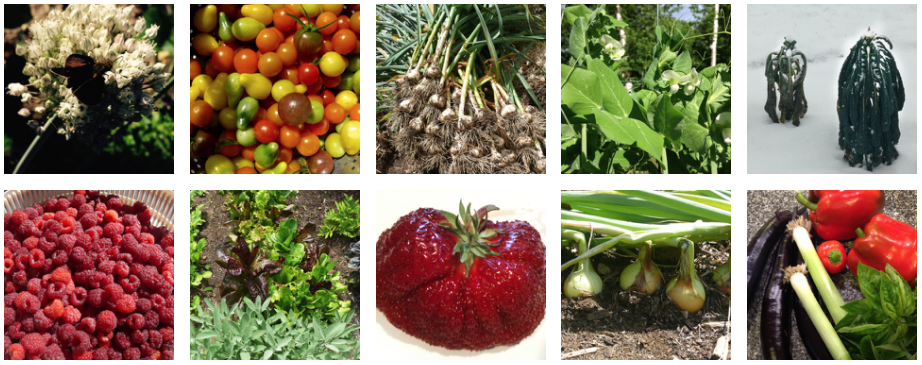
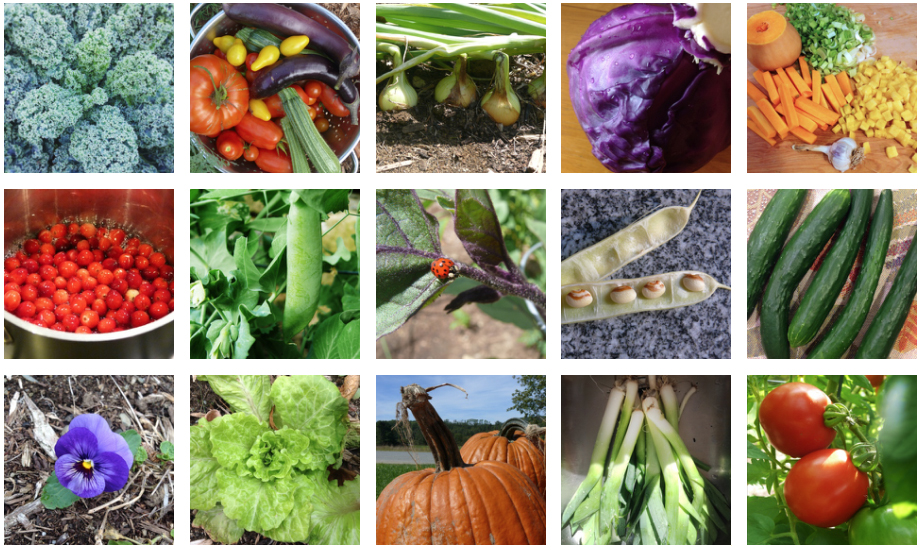
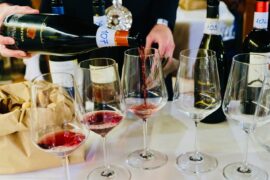

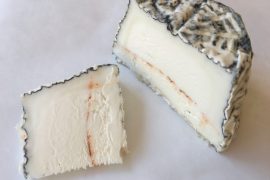
You finished!
A beautiful work. Loved this:
“I’m an experienced scratch cook. I figure my job is to take perfect ingredients and coax them into their highest and best state.”
Also, the geological preface and the premise of the challenge. Indeed, an abundant time of year in New England and one I miss terribly.
Thank you for sharing. I may replicate the challenge at some point, although it would look much different, I suppose.
Thank you so much, Alissa. I’d love to read your follow-up if you do try this at home.
Bravo! Cooking all/mostly local is a joy and a challenge. It probably needs to be both. I really enjoyed reading this. Would comment more but for a locally acquired (my own oven) burn on my thumb. 🙂
Thanks, David, for reading and for commenting despite your kitchen battle scar.